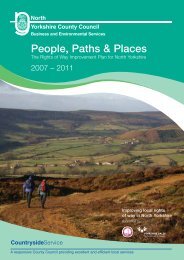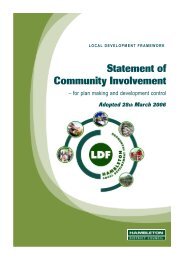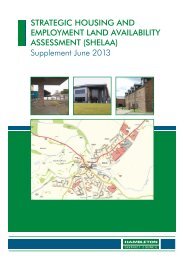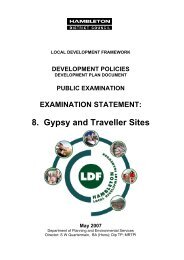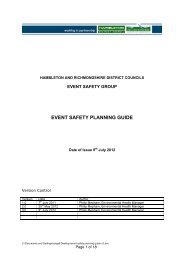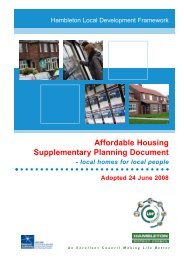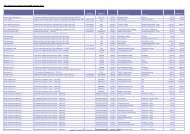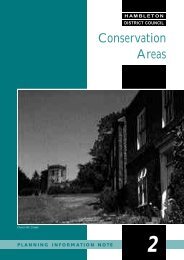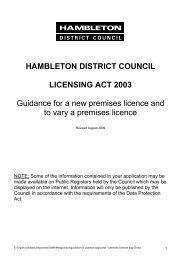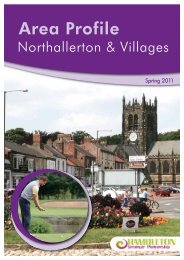Strategic Flood Risk Assessment - Hambleton District Council
Strategic Flood Risk Assessment - Hambleton District Council
Strategic Flood Risk Assessment - Hambleton District Council
Create successful ePaper yourself
Turn your PDF publications into a flip-book with our unique Google optimized e-Paper software.
latterly the maps were reissued in April 2004 as <strong>Flood</strong> Maps with <strong>Flood</strong> Zones<br />
incorporated for use by local planning authorities. These maps are regularly<br />
updated by the Environment Agency and are published on their website.<br />
3.19 The <strong>Flood</strong> Map is a tool to raise awareness of flood risk with the public, local<br />
authorities, emergency services and drainage authorities. The <strong>Flood</strong> Zones<br />
are incorporated within the <strong>Flood</strong> Map so that Planning Authorities can have<br />
easy access to information to support the implementation of PPG25 and the<br />
sequential test.<br />
3.20 The flood map information is indicative rather than specific and recipients of<br />
the flood map may need to consult the Environment Agency where<br />
appropriate. The Environment Agency will update this data as better<br />
information becomes available e.g. changes in hydrological river response,<br />
observations following flood events or improved modelling techniques.<br />
<strong>Risk</strong>-based approach and the sequential test<br />
3.21 LPA’s should adopt a risk-based approach to proposals for development in or<br />
affecting flood-risk areas. The assessment of risk should take account of:<br />
• the area liable to flooding;<br />
• the probability of it occurring, both now and over time;<br />
• the extent and standard of existing flood defences and their effectiveness<br />
over time;<br />
• the likely depth of flooding;<br />
• the rates of flow likely to be involved;<br />
• the likelihood of impacts to other areas, properties and habitats;<br />
• the effects of climate change;<br />
• the nature and current expected lifetime of the development proposed and<br />
the extent to which it is designed to deal with flood risk.<br />
3.22 The Government expects local planning authorities to apply a risk-based<br />
approach to the preparation of development plans and their decisions on<br />
development control through a sequential test. Developers seeking sites for<br />
housing and other development should also have regard to this test.<br />
3.23 Accordingly, in drawing up or revising policies in development plans and in<br />
considering applications for development in cases where plans do not yet<br />
reflect the following, local planning authorities should give priority in allocating<br />
or permitting sites for development, in descending order to the <strong>Flood</strong> Zones<br />
set out below, including sub-divisions in Zone 3. When allocating land in<br />
development plans or deciding applications for development at a particular<br />
location, those responsible for the decision would be expected to demonstrate<br />
that there are no reasonable options available in a lower-risk category,<br />
consistent with other sustainable objectives.<br />
3.24 Locally in all zones, an assessment may be needed of the risk of groundwater<br />
flooding or local flooding due to overland sheet flow or run-off exceeding the<br />
capacity of the drainage systems during prolonged or intense rainfall. <strong>Flood</strong>resistant<br />
construction may be required in all areas, depending on the results<br />
of that assessment. The run-off implications of development should be<br />
assessed for all zones and controlled, where possible through the use of<br />
sustainable drainage systems (SUDS).<br />
9



